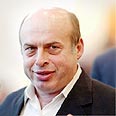
US remembers fight for Soviet Jewry
Jewish Historical Society of Greater Washington working to ensure years of efforts to save Jews trapped behind Iron curtain are not forgotten, with exhibition called Voices of Vigil
Every day for over 20 years, between 12:30 and 12:45 pm, protestors staged some form of demonstration, from dancing "Hava Nagila" to reading Hebrew prayers.
Video courtesy of jn1.tv
Marcia Weinberg was one such activist. She explains what it was like, keeping the vigil.
"It was very much a different kind of feel, depending on what was going on that day and who was there. Every synagogue had a day and everybody had to take responsibility for bringing their group out. And they did. It was quite amazing," she says.
Now, the Jewish Historical Society of Greater Washington is working to make sure these years of efforts are not forgotten, with an exhibition called Voices of the Vigil.
Wendy Turman, head curator of the project, described the conditions the so-called 'refuseniks' faced in Soviet Union.
"They weren't able to leave," she says. "People would apply for a visa to leave for the United States. Jews, a lot of Jews, were not able to practice their chosen profession or go to the university that they wanted to attend. And If they spoke out, they ran the risk of losing their job, losing their employment, or worse, being in prison or sent to a work camp in Siberia."
But keeping the vigil was only one of many ways in which Americans Jewry petitioned on behalf of their Soviet counterparts. December 6, 2013 marked the 25th anniversary of a March on Washington in the lead up to a meeting between then-President Ronald Reagan and Soviet leader Mikhail Gorbachev. Some 250,000 protestors came, demanding freedom for Soviet Jews.
The speakers at the march included noted human rights activists and Jewish Agency Chairman Natan Sharansky, who returned to Washington for this exhibit's debut.
"I had a team of 17 interrogators and the colonel became very angry and started shouting. He said, 'What do you think they will help you, these people will help you? Look, look at the screen who they are – they are a bunch of students and housewives? And we are KGB.'"
Sharansky adopted the term, and the so-called movement of "students and housewives" – everyday civilians following their consciences – turned out to have a powerful effect.
Marcia Weinberg says that the decades-long movement was a testament to the strength of the community, setting a powerful example for just what can be accomplished in the future.
"You know, there's that wonderful saying, 'He who saves a single life saves a world...' Well, almost two million Jews from the Soviet Union, their whole world were saved because all of us together made it happen," she says.
With the collapse of the Soviet Union in 1991, the vigil finally came to an end and activists remember those years with great pride as the so-called band of "students and housewives" came together to make a difference.










